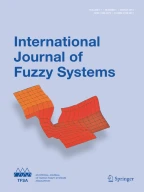Abstract
This study proposes a new fuzzy time series model based on Fuzzy C-Regression Model clustering algorithm (FCRMF). There are two major superiorities of FCRMF in comparison with existing fuzzy time series model based on fuzzy clustering. The first one is that FCRMF partitions data set by taking into account the relationship between the classical time series and lagged values, and thus, it gives the more realistic clustering results. The second one is that FCRMF produces different forecasting values for each data point, while the other fuzzy time series methods produce same forecasting values for many data points. In order to validate the forecasting performance of proposed method and compare it to the other fuzzy time series methods based on fuzzy clustering, six simulation studies and two real-time examples are carried out. According to goodness-of-fit measures, it is observed that FCRMF provides the best forecasting results, especially in cases when time series are not stationary. When considering that fuzzy time series was proposed especially for cases that time series do not satisfy statistical assumptions such as the stationary, this is very important advantage.
Similar content being viewed by others
Explore related subjects
Discover the latest articles, news and stories from top researchers in related subjects.References
Song, Q., Chissom, B.S.: Fuzzy time series and its models. Fuzzy Set Syst. 54, 269–277 (1993)
Song, Q., Chissom, B.S.: Forecasting enrollments with fuzzy time series—part I. Fuzzy Set Syst. 54, 1–9 (1993)
Song, Q., Chissom, B.S.: Forecasting enrollments with fuzzy time series—part II. Fuzzy Set Syst. 62, 1–8 (1994)
Sullivan, J., Woodall, W.H.: A comparison of fuzzy forecasting and Markov model. Fuzzy Set Syst. 64(3), 279–293 (1994)
Chen, S.M.: Forecasting enrollments based on fuzzy time series. Fuzzy Set Syst. 81(3), 311–319 (1996)
Hwang, J.R., Chen, S.M., Lee, C.H.: Handling forecasting problems using fuzzy time series. Fuzzy Set Syst. 100, 217–228 (1998)
Huarng, K.: Heuristics models of fuzzy time series for forecasting. Fuzzy Set Syst. 123(3), 369–386 (2001)
Huarng, K.: Effective lengths of intervals to improve forecasting in fuzzy time series. Fuzzy Set Syst. 123(3), 387–394 (2001)
Huarng, K., Yu, H.K.T.: Ratio-based lengths of intervals to improve fuzzy time series forecasting. IEEE Trans. Syst. Man Cybern. Syst. 36(2), 328–340 (2006)
Yolcu, U., Eğrioğlu, E., Uslu, V.R., Basaran, M.A., Aladağ, C.H.: A new approach for determining the length of intervals for fuzzy time series. Appl. Soft Comput. 9(2), 647–651 (2009)
Eğrioğlu, E., Aladağ, C.H., Basaran, M.A., Yolcu, U., Uslu, V.R.: A new approach based on the optimization of the length of intervals in fuzzy time series. J. Intell. Fuzzy Syst. 22(1), 15–19 (2011)
Cheng, C.H., Cheng, G.W., Wang, J.W.: Multi-attribute fuzzy time series method based on fuzzy clustering. Expert Syst. Appl. 34, 1235–1242 (2008)
Li, S.T., Cheng, Y.C., Lin, S.Y.: A FCM-based deterministic forecasting model for fuzzy time series. Comput. Math Appl. 56, 3052–3063 (2008)
Eğrioğlu, E., Aladağ, C.H., Yolcu, U., Uslu, V.R., Erilli, N.A.: Fuzzy time series forecasting method based on Gustafson–Kessel fuzzy clustering. Expert Syst. Appl. 38, 10355–10357 (2011)
Eğrioğlu, E., Aladağ, C.H., Yolcu, U.: Fuzzy time series forecasting with a novel hybrid approach fuzzy c-means and neural networks. Expert Syst. Appl. 40, 854–857 (2013)
Chen, S.M.: Forecasting enrollments based on high-order fuzzy time series. Cybern. Syst. 33(1), 1–16 (2002)
Chen, S.M., Chung, N.Y.: Forecasting enrollments based on high-order fuzzy time series and genetic algorithms. Int. J. Int. Syst. 21(5), 485–501 (2006)
Jilani, T.A., Burney, S.M.A.: M-factor high order fuzzy time series forecasting for road accident data. Adv. Soft Comput. 34(1), 328–336 (2007)
Lee, L.W., Wang, L.H., Chen, S.W.: Temperature prediction and TAIFEX forecasting based on high-order fuzzy logical relationships and genetic simulated annealing techniques. Expert Syst. Appl. 34(1), 485–501 (2008)
Eğrioğlu, E., Aladağ, C.H., Yolcu, U., Uslu, V.R., Basaran, M.A.: A new approach based on artificial neural network for high order multivariate fuzzy time series. Expert Syst. Appl. 36(7), 10589–10594 (2009)
Eğrioğlu, E., Aladağ, C.H., Yolcu, U., Uslu, V.R., Basaran, M.A.: Finding an optimal interval length in high order fuzzy time series. Expert Syst. Appl. 37(7), 5052–5055 (2010)
Hathaway, R.J., Bezdek, J.C.: Switching regression models and fuzzy clustering. IEEE Trans. Fuzzy Syst. 1(3), 195–204 (1993)
Bezdek, J.C.: Pattern Recognition with Fuzzy Objective Function Algorithms. Plenum, New York (1981)
Gustafson, D.E., Kessel, W.C.: Fuzzy clustering with a fuzzy covariance matrix. In: Proc. IEEE Conf. Decision Contr., pp. 761–766 (1979)
Runkler, T.A., Seeding, H.G.: Fuzzy c-auto regression models. In: IEEE World Congress on Computational Intelligence, pp. 1818–1825 (2008)
Cheng, C.H., Chang, J.R., Yeh, C.A.: Entropy-based and trapezoid fuzzification fuzzy time series approaches for forecasting IT project cost. Technol. Forecast. Soc. 73, 524–542 (2006)
Author information
Authors and Affiliations
Corresponding author
Rights and permissions
About this article
Cite this article
Güler Dincer, N. A New Fuzzy Time Series Model Based on Fuzzy C-Regression Model. Int. J. Fuzzy Syst. 20, 1872–1887 (2018). https://doi.org/10.1007/s40815-018-0497-0
Received:
Revised:
Accepted:
Published:
Issue Date:
DOI: https://doi.org/10.1007/s40815-018-0497-0
